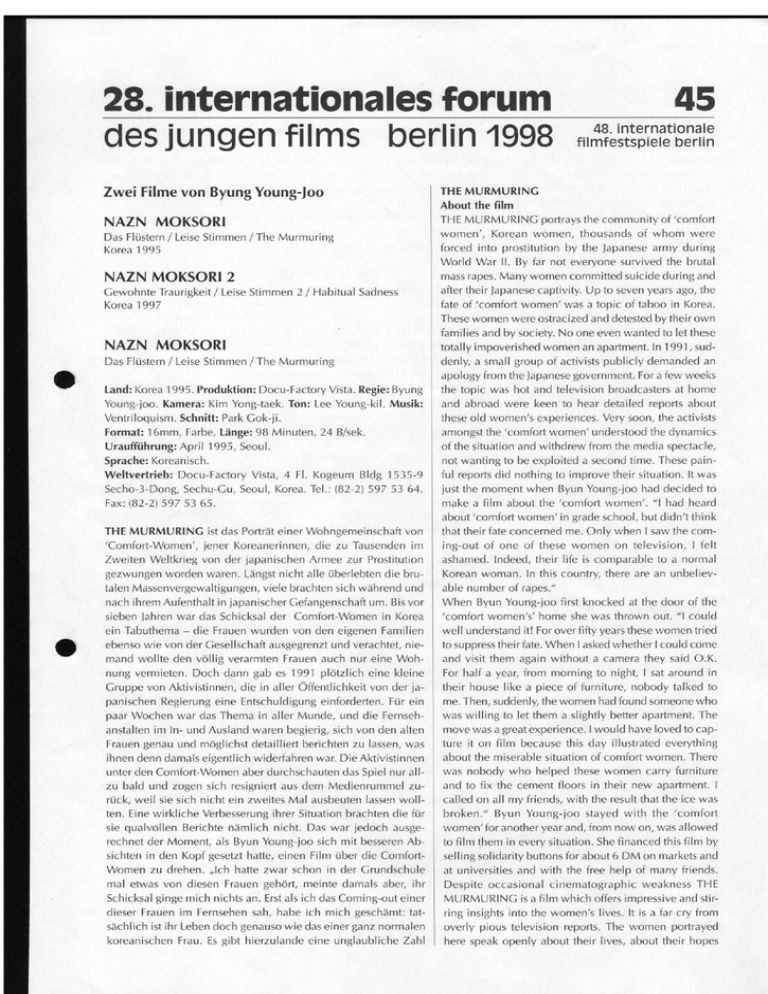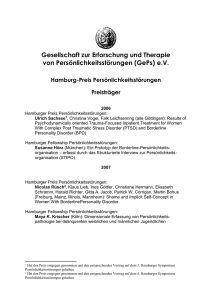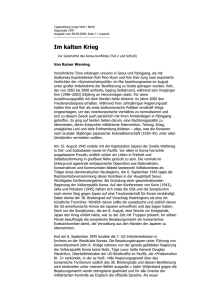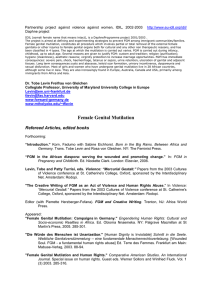28. internationales forum
Werbung

28. internationales forum des jungen films berlin1998 Zwei Filme von Byung Young-Joo NAZN MOKSORI Das Flüstern / Leise Stimmen / The Murmuring Korea 1995 NAZN MOKSORI 2 Gewohnte Traurigkeit / Leise Stimmen 2 / Habitual Sadness Korea 1997 NAZN MOKSORI Das Flüstern / Leise Stimmen / The Murmuring Land: Korea 1995. Produktion: Docu-Factory Vista. Regie: Byung Young-joo. Kamera: Kim Yong-taek. Ton: Lee Young-kil. Musik: Ventriloquism. Schnitt: Park Gok-ji. Format: 16mm, Farbe. Länge: 98 Minuten, 24 B/sek. Uraufführung: April 1995, Seoul. Sprache: Koreanisch. Weltvertrieb: Docu-Factory Vista, 4 Fl. Kogeum Bldg 1535-9 Secho-3-Dong, Sechu-Gu, Seoul, Korea. Tel.: (82-2) 597 53 64. Fax: (82-2) 597 53 65. THE MURMURING ist das Porträt einer Wohngemeinschaft von 'Comfort-Women', jener Koreanerinnen, die zu Tausenden im Zweiten Weltkrieg von der japanischen Armee zur Prostitution gezwungen worden waren. Längst nicht alle überlebten die brutalen Massenvergewaltigungen, viele brachten sich während und nach ihrem Aufenthalt in japanischer Gefangenschaft um. Bis vor sieben Jahren war das Schicksal der Comfort-Women in Korea ein Tabuthema - die Frauen wurden von den eigenen Familien ebenso wie von der Gesellschaft ausgegrenzt und verachtet, niemand wollte den völlig verarmten Frauen auch nur eine Wohnung vermieten. Doch dann gab es 1991 plötzlich eine kleine Gruppe von Aktivistinnen, die in aller Öffentlichkeit von der japanischen Regierung eine Entschuldigung einforderten. Für ein paar Wochen war das Thema in aller Munde, und die Fernsehanstalten im In- und Ausland waren begierig, sich von den alten Frauen genau und möglichst detailliert berichten zu lassen, was ihnen denn damals eigentlich widerfahren war. Die Aktivistinnen unter den Comfort-Women aber durchschauten das Spiel nur allzu bald und zogen sich resigniert aus dem Medienrummel z u rück, weil sie sich nicht ein zweites Mal ausbeuten lassen w o l l ten. Eine wirkliche Verbesserung ihrer Situation brachten die für sie qualvollen Berichte nämlich nicht. Das war jedoch ausgerechnet der Moment, als Byun Young-joo sich mit besseren A b sichten in den Kopf gesetzt hatte, einen Film über die ComfortWomen zu drehen. „Ich hatte zwar schon in der Grundschule mal etwas von diesen Frauen gehört, meinte damals aber, ihr Schicksal ginge mich nichts an. Erst als ich das Coming-out einer dieser Frauen im Fernsehen sah, habe ich mich geschämt: tatsächlich ist ihr Leben doch genauso wie das einer ganz normalen koreanischen Frau. Es gibt hierzulande eine unglaubliche Zahl 45 THE MURMURING About the film THE M U R M U R I N G portrays the community of 'comfort w o m e n ' , Korean women, thousands of whom were forced into prostitution by the Japanese army during World War II. By far not everyone survived the brutal mass rapes. Many women committed suicide during and after their Japanese captivity. Up to seven years ago, the fate of 'comfort women' was a topic of taboo in Korea. These women were ostracized and detested by their own families and by society. No one even wanted to let these totally impoverished women an apartment. In 1991, suddenly, a small group of activists publicly demanded an apology from the Japanese government. For a few weeks the topic was hot and television broadcasters at home and abroad were keen to hear detailed reports about these old women's experiences. Very soon, the activists amongst the 'comfort women' understood the dynamics of the situation and withdrew from the media spectacle, not wanting to be exploited a second time. These painful reports did nothing to improve their situation. It was just the moment when Byun Young-joo had decided to make a film about the 'comfort women'. "I had heard about 'comfort women' in grade school, but didn't think that their fate concerned me. Only when I saw the coming-out of one of these women on television, I felt ashamed. Indeed, their life is comparable to a normal Korean woman. In this country, there are an unbelievable number of rapes." When Byun Young-joo first knocked at the door of the 'comfort women's' home she was thrown out. "I could well understand it! For over fifty years these women tried to suppress their fate. When I asked whether I could come and visit them again without a camera they said O.K. For half a year, from morning to night, I sat around in their house like a piece of furniture, nobody talked to me. Then, suddenly, the women had found someone who was willing to let them a slightly better apartment. The move was a great experience. I would have loved to capture it on film because this day illustrated everything about the miserable situation of comfort women. There was nobody who helped these women carry furniture and to fix the cement floors in their new apartment. I called on all my friends, with the result that the ice was broken." Byun Young-joo stayed with the 'comfort women' for another year and, from now on, was al lowed to film them in every situation. She financed this film by selling solidarity buttons for about 6 D M on markets and at universities and with the free help of many friends. Despite occasional cinematographic weakness THE M U R M U R I N G is a film which offers impressive and stirring insights into the women's lives. It is a far cry from overly pious television reports. The women portrayed here speak openly about their lives, about their hopes von Vergewaltigungen." Als Byun Young-joo das erste Mal bei den Comfort-Women zu Hause anklopfte, wurde sie rausgeschmissen. „Ich konnte das gut verstehen! Über fünfzig Jahre haben diese Frauen versucht, ihr Schicksal irgendwie zu verdrängen. Als ich fragte, ob ich sie - ohne Kamera - wieder besuchen dürfte, sagten sie 'ok'. Ein halbes Jahr lang habe ich dann von morgens bis Mitternacht wie ein Möbelstück bei ihnen im Haus herumgesessen, niemand sprach mit mir. Dann plötzlich hatten die Frauen jemanden gefunden, der ihnen eine etwas bessere Wohnung vermieten wollte. Der Umzug war ein großartiges Erlebnis, und ich hätte es wahnsinnig gerne gefilmt, weil dieser Tag alles über die miese Lebenssituation der Comfort-Women gezeigt hätte. Niemand war da, der diesen alten Frauen half, die Möbel zu tragen oder den nackten Betonboden der neuen Wohnung herzurichten. Also trommelte ich alle meine Freunde zusammen, und seitdem war das Eis gebrochen." Byun Young-joo lebte ein weiteres Jahr mit den Comfort-Women in dem neuen Haus und durfte fortan in allen Lebenslagen drehen. Finanziert hat sie diesen Film durch den Verkauf von Solidaritäts-Buttons zu umgerechnet 6 D M auf Märkten und in Universitäten - und durch die unentgeltliche Hilfe vieler Freunde. THE M U R M U R I N G ist ein Film geworden, der trotz einiger cinematographischer Schwächen eindrucksvolle, aufwühlende Einsichten in Biographien bietet, die sich von den bigotten TV-Reportagen krass unterscheiden. Die porträtierten Frauen reden offen über ihre Lebensgeschichten, über ihre Hoffnungen und Ängste. Manchmal zynisch, manchmal verzweifelt äußern sie Selbstmordabsichten, dann wieder necken sie sich gegenseitig beim Fernsehen mit äußerst coolen Sprüchen. In den Kinos von Seoul wurde der Film ein Publikumserfolg, mit dem Resultat, daß die zuvor verachteten Comfort-Women von damals selbst zu Filmstars wurden und vor wenigen Monaten in ein komfortables Landhaus umziehen konnten. Nach diesem Erfolg wurde Byun von einer kommerziellen Filmproduktion dazu gedrängt, eine Komödie zu drehen, doch floh sie erst einmal in das Haus ihrer betagten Freundinnen, um sich mit ihnen zu beraten. Dorothée Wenner NAZN MOKSORI 2 Habitual Sadness / Gewohnte Traurigkeit / Leise Stimmen 2 Land: Korea 1997. Produktion: Doku-Factory VISTA. Regie: Byung Young-joo. Kamera: Kim Yong-taek. Ton: Lee Young-kil. Musik: Film Musik Factory Ventriloquism. Schnitt: Park Gok-ji. Produzent: Shin Myoung-hwa. Format: 35mm, 1:1.37, Farbe. Länge: 71 Minuten, 24 B/sek. Uraufführung: 14. August 1997, Dong-Soon, Arts Center/Seoul Cinematheque. Sprache: Koreanisch. Weltvertrieb: Jane Balfour Films Ltd., Burghley House, 35 Fortess Road, GB-London N W 5 IAQ. Tel.: (44-171) 267 5392, Fax: (441 71 ) 267 42 41. e-mail: [email protected]. Inhalt Auf Drängen der Hauptdarstellerinnen ihres vorangegangenen Films The Murmuring drehte Byun Young-joo HABITUAL SADNESS. Dabei ist keine simple Fortsetzung entstanden: Die ehemaligen Zwangsprostituierten haben durch den Erfolg von The Murmuring eine sonderbare Transformation durchgemacht. Inzwischen sind sie nicht mehr die unbekannten Opfer, die stellvertretend für 200.000 andere zur Prostitution gezwungene Frauen das fünfzigjährige Schweigen gebrochen haben. Das politische and fears. At times cynical or despondant, they express suicidal intentions, then again they tease each other whilst watching television with very cool comments. In Seoul cinemas the film was a success with audiences, with the result that the 'comfort women', previously held in contempt, became film stars and, within a few months, were able to move into a comfortable country home. After her success, commercial film producers pressed Byun to make a comedy, but she fled to the home of her old girlfriends to consult with them. Dorothée Wenner HABITUAL SADNESS Synopsis After being encouraged by the protagonists of her previous film The Murmuring, Byun Young-joo subsequently made HABITUAL SADNESS. It is, however, more than a sequel. The former prostitutes have undergone a remarkable transformation since The Murmuring. In the meanwhile, they no longer are unknown victims of forced prostitution, representatives for 200,000 women, who have broken the vow of a 50-year-silence. The period of political relaxation in South Korea, their sudden identity as 'feminist film stars' changed their lives at a time when they had long accepted the fact they would end their ruined lives as lonely, despised women. They have achieved a certain 'feminist' popularity in Korea which helped them to realize a dream. The old ladies moved to a country house near Kwangju where they keep chicken, grow chili, go to weekly demonstrations, manage the household together, irritate and tease each other. They are closer than most normal families in Korea or elsewhere. HABITUAL SADNESS portrays a group of women who arouse a peculiar mixture of admiration and sympathy in the audience. The unique story of HABITUAL SADNESS is convincingly presented by Byun Young-joo. Since the women have learned a thing or two about filmmaking, they occasionally give directions or want to be filmed in a particular situation. This is especially amusing in everyday life when they drink together. Their self-confident behaviour also pushes the young filmmaker to the limits of her capabilities, for example, when artistically talented Kang Suk-Kyung asks Byun Young-joo to document her slow death. It is quite possible that their friendship kept the filmmaker's voyeurism at bay. She managed to document the final months of an old, feisty woman, showing how her death left her closest friends bereaved. H A BITUAL SADNESS features some of Kang Suk-Kyung's paintings which give eloquent testimony to the brutal experiences the young painter had to endure and which she never forgot. There is an affinity between these paintings and the film. In both cases, the work is so meaningful that aesthetic objections seem invalid or smallminded. What Byun Young-joo shares with the former prostitutes is the sense of injustice which they feel women suffer in Korean society even today. It is rather encouraging that a young Korean filmmaker succeeds in illustrating a continuity between war crimes of the past and contemporary society.











